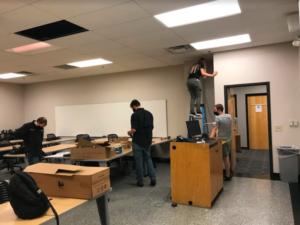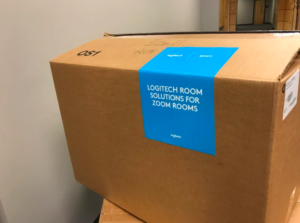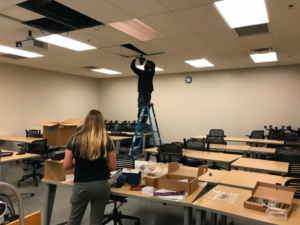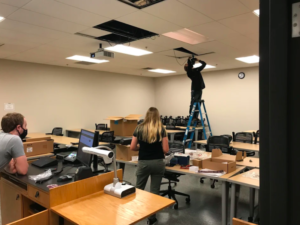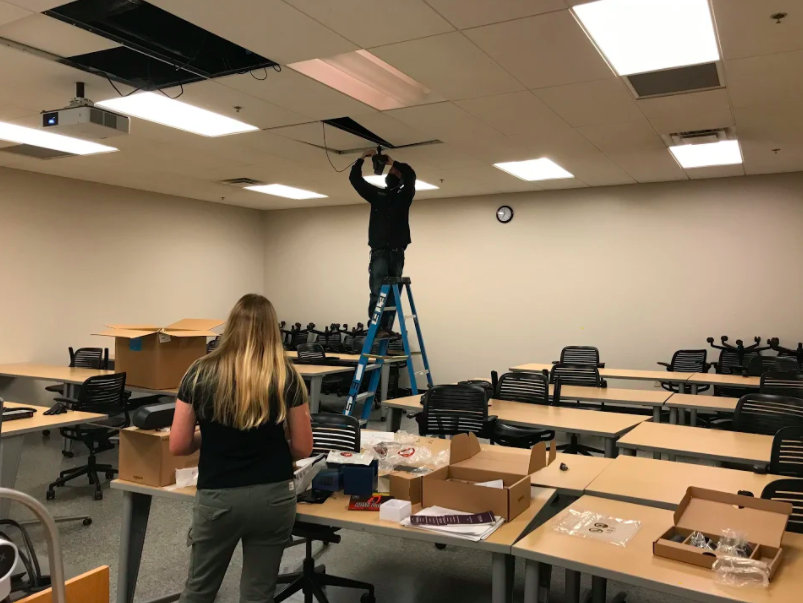Lipscomb is responding to the COVID pandemic by instituting LipscombFLEX, a classroom model that will accommodate health protocols and still allow students and faculty to interact.
“The goal of the LipscombFLEX method is that students should receive an equivalent experience whether they are physically in the classroom or learning online,” said Andy Borchers, Lipscomb University professor and coordinator for fall classroom accommodations.
LipscombFLEX will use video conferencing, new cameras, microphones, and online platforms to allow faculty to teach both students in the classroom and remotely online. Instruction has the option to be either all at the same class time or in asynchronous methods such as online written discussion groups or collaborative web platforms.
“The new LipscombFLEX model essentially has every professor preparing for face-to-face class, but also fully preparing to be remote and online if they need to be,” said Lipscomb President Randy Lowry.
Borchers describes a three-part plan for applying this modified Hyflex (short for “hybrid’’ and ‘‘flexible’’) model in education for the fall semester.
“First, we inventoried all of the classrooms, to see how many students we could seat following the 6-feet limitations, which came out to about 30 percent to 50 percent capacity,” said Borchers.
“Then we identified 40 classrooms across the campus that are going to receive a ‘Zoom Room’ installation,” Borchers said. “It will mean having a camera mounted typically on the ceiling with microphones, allowing teachers a mixture of students either physically in the room or remote.”
More than 60 percent of students enrolled in classes will be in one of the “Zoom Rooms’’ on campus, while the other 40 percent will be divided into cohorts, using similar technology such as microphones, portable webcams, and screen-sharing technology, said Borchers.
Classes requiring students to be divided into cohorts means students will take turns learning online or physically in the classroom to maintain social distancing protocols.
Several larger spaces such as the Collins Alumni Auditorium and the SunTrust Center for Collaborative Learning in the Ezell Center will be used to accommodate larger class sizes, according to Borchers.
“Lastly, the university faculty has been training in learning the new technology, how to manage their classroom, designing curriculum for both formats, as well as the details of public health guidelines and procedure,” Borchers said.
Some courses may also utilize a facilitator in the class to monitor and ensure online student participation. Students and faculty members can also record videos of lectures or student presentations to view outside of regular class meeting times.
“Your professors are working really, really hard because they are preparing each of their classes in two different formats to accommodate students,” said Lowry.
Faculty has been working to design course curriculum to work both in-person and online simultaneously, providing the flexibility to switch formats at any time, for any particular student or for all students if need be, said Borchers.
“Our No. 1 goal for the fall is to make sure students have a productive academic semester,” said Lowry. “If you end up getting sick and having to be home for two weeks, your education will not be interrupted, and we want to make sure your academic progress continues.”
A classroom financial budget of $300,000 was used to accommodate and launch the LipscombFLEX technology throughout the campus, according to Borchers.
“This technology and the training faculty did to use it, will be very valuable on the other side of COVID as well,” said Borchers. “We will be a different institution for doing this and probably a better one in the future.”
*Additional reporting done by Mckenzi Harris
Photos courtesy of Lipscomb University.
